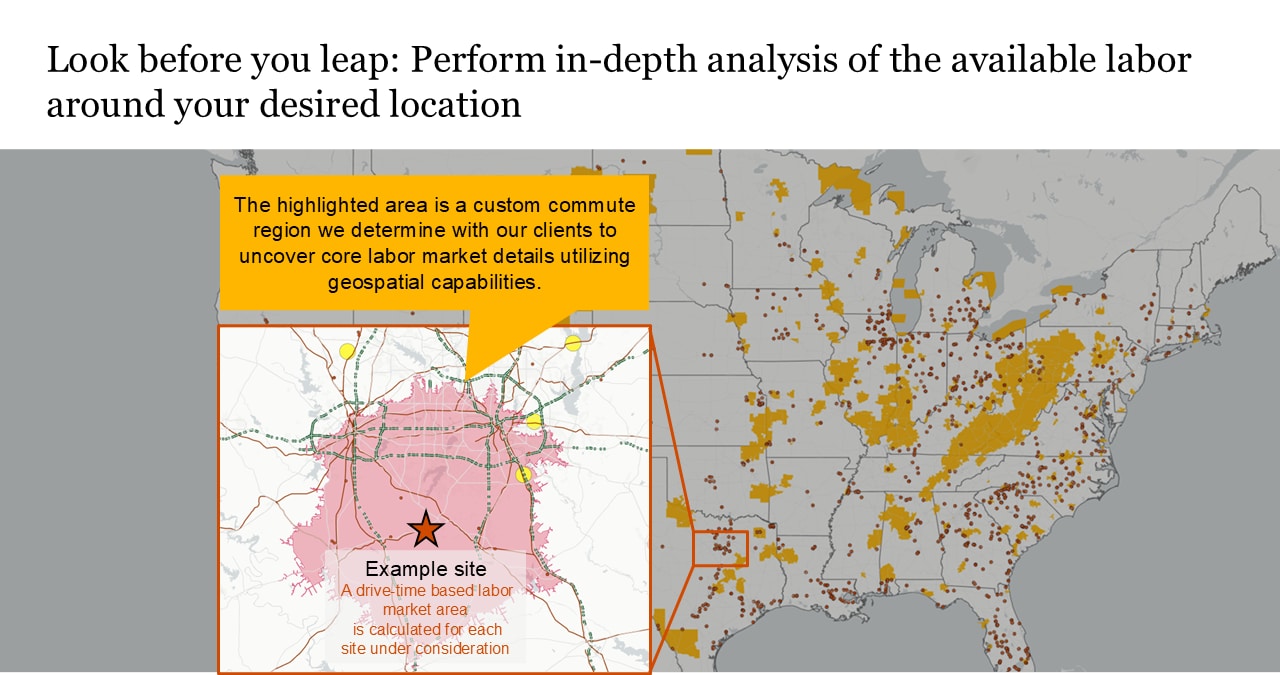{{item.title}}
{{item.text}}

{{item.text}}
The movement of manufacturing and other corporate operations back to the US is growing in importance, mainly driven by changing global trade policies that may make the US a more attractive option and by the desire to remain close to suppliers that are also onshoring operations.
Today’s site selection committees typically face challenges that are different from those of prior reshoring waves. The pandemic’s effects on migration patterns and housing costs often make it more difficult to assess where workers live and how far they are willing to commute. At the same time, many companies are upping the ante, seeking employees who are technologically and mechanically literate to work in today’s computer-laden operations. And as more manufacturing, warehousing and data center operations are built in the US, a location’s characteristics change. Site selection committees should carefully weigh how their operations and those of other companies could detract from a location’s access to roads, ports, electricity and other inputs.
Committees seeking to make better informed decisions are arming themselves with growing volumes of granular data and sifting it using the latest artificial intelligence tools to help them gain clarity, precision and strategic foresight.
Tech tools to help guide site selection are often essential as the country experiences a boom in onshoring. We can get a sense of this boom by looking at domestic manufacturing real estate capital expenditures as a proxy. There has been a doubling of that type of spending between 2021 and 2024 following the Biden administration’s passage of two significant pieces of industrial policy legislation.
Real private fixed investment in structures: Nonresidential: Manufacturing; Index 1951=100, Annual, Not Seasonally Adjusted; Source US Bureau of Economic Analysis
Such rapid increases in spending indicate that companies bringing manufacturing or other operations back to the US should be prepared for fierce competition for qualified talent, attractive sites and financial incentives.
Given the broad range of concerns for site selection committees, a process that produces deep insights is an integral component for capitalizing on the advantages the US offers while mitigating the risks of making a high-stakes error. A rigorous, data-driven approach can quantify and score labor availability, climate risks, logistics, utility capacity, seismic activity and other factors. Those scores can then be used to programmatically detect and highlight sites matching your strategic vision.
Among the more important considerations of site selection committees in today’s onshoring wave are the skills, availability and compensation expectations of individuals who live within a relatively short drive of your future facility. But you won’t find data covering skills, availability and compensation expectations in a single database. Instead, information from job listings and government and private sources has to be aggregated, standardized and analyzed. Artificial intelligence tools, operating within an Responsible AI approach, are often well suited for this complex task.
AI-powered labor market analysis tools, for example, can perform hyper-local diligence on workers within commuting distance of sites you’re considering. By incorporating alternative datasets, you can assess that the people in a particular area possess the necessary skills, whether that’s certain types of drivers’ licenses, professional certifications or specialized education. AI can also quickly assess migration trends and local wage conditions and evaluate other regional hiring activities to help measure what it would take to make your project competitive in the labor market.
A strong local workforce supports long-term viability. Companies often find bootstrapping a labor pool in the wrong locale is like pushing on a string. They should have the right labor pool near their site — or they at least should determine whether the proper precursor conditions and worker training pipelines exist to support their facility. In our experience, talent availability varies widely and two sites in the same metropolitan statistical area can have very different access to labor given complex commuting patterns. Therefore, it’s very important to assess that suitable talent is available.
The art of site selection demands clarity, precision and strategic foresight. Adopting a scientific approach that combines workforce analysis, logistical efficiency, strong infrastructure and smart use of local and federal incentives can help you counter global uncertainties and lay a foundation for long-term success.
{{item.text}}

{{item.text}}

